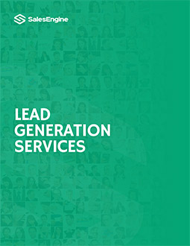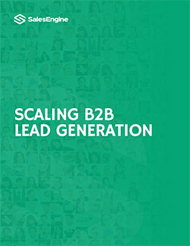Category:
3 Tips to Better B2B Prospecting
| 0
Successful sales teams have a consistent supply of qualified sales leads to contact, follow up, schedule meetings, and close. Without an efficient prospect discovery process at the top of your sales pipeline, your salespeople may be unable to reach quotas and produce the sales growth your company needs.
This post walks you through three easy tips to help jumpstart a prospecting process for your team: prospecting goals, target research, and database management. Whether you are a startup or a Fortune 500 company, having valuable and consistent lists of leads for your salespeople is paramount to creating predictable revenue streams.
Tip One: Identify Prospecting Goals
The most successful prospecting processes help your sales teams crush quotas and reach company-wide sales goals. B2B prospecting should revolve around the specific needs of your company. Because this process brings a consistent flow of qualified sales leads to your salespeople, it is advantageous to be specific about how prospecting can create predictable revenue streams and produce sales growth.
Using historical data in your CRM, you can calculate the closing rate and customer lifetime value of different target segments. This acts as a great road map for the profitability of a prospecting endeavor. If CEOs in the Healthcare industry have a 5% close rate for $12,000 in annual recurring revenue, for example, then bringing 1,000 of those leads to your salespeople through prospecting produces a potential $600,000 in annual revenue.
Tip Two: Use Research to Personalize
The more relevant and qualified leads are for salespeople, the more valuable they will be in your sales pipeline. Doing research on the firmographic and demographic characteristics of profitable target segments help guide your prospecting efforts. With data sources like LinkedIn and Zoominfo, your prospecting accuracy can be refined to specific company sizes, locations, and even role-specific characteristics like employee function and experience.
This information makes your lead lists targeted and measurable. It also gives your salespeople the ability to personalize outreach based on the knowledge they have on a prospect. Better insight on prospects gives your sales team the ability to improve outbound campaigns and follow up performance. In addition, having more information on prospects creates a data-driven lead generation process. With more data comes better targeting, giving your sales team the ability to find the most responsive and relevant leads.
Tip Three: Maintain Your Database
Prospecting can produce profitable results for B2B companies, but it can be a challenge to manage and improve your data. According to Marketing Sherpa, B2B data decays at an average rate of 2.1% per month. This creates an average of 22.5% bad leads over the course of a year, posing the potential to hurt your lead generation efforts. To prevent this from happening, your prospecting data should be frequently updated and put through quality assurance tests.
This problem grows with the size of your database, and can vary depending on the data source you use to build lead lists. Striving to maintain relevant and recent data is the best way to sustain a profitable prospecting process for your sales team.
Is There a Better Way to Prospect?
The right prospecting component can create a predictable revenue stream for your company. However, the costs and time involved in prospecting can be challenging to mitigate, and internal efforts can take months of training and database development to become profitable.
The best alternative to filling your pipeline with a steady supply of targeted leads is to use a service provider that specializes in creating high-quality and accurate lead lists. Companies like SalesEngine leverage a combination of big data analysis, artificial intelligence, experienced prospectors, and sales development expertise to develop prospecting lists of qualified sales leads at scale. This produces a flow of leads to your salespeople quickly, and without the need for a costly and time-consuming internal team. Overall, prospecting is the driver of B2B sales growth, and the capabilities of your prospecting efforts define the true potential of your sales pipeline.



